Blenheim Palace was built to celebrate the victory over the French in the Battle at Blenheim, a major battle of the War of the Spanish Succession at the German village Blenheim (Blindheim). Blenheim Palace was a gift to John Churchill, 1st Duke of Marlborough, who led the Allied forces during the Battle at Blenheim. Blenheim Palace is a large and monumental building situated in small the village of Woodstock in Great Britain. Blenheim Palace is one of the largest country houses in England and the only non-royal house in England to hold the title palace. The palace was designed by the English architect John Vanbrugh and built between 1705 and 1724, the design of the palace was strongly influenced by the Palladian architecture. Blenheim Palace lies in a park created by the renowned English landscape designer Lancelot 'Capability' Brown, he designed more than 170 parks, among them Kew Gardens in London. The Triumphal Arch, also known as the Woodstock Gate, was built in 1723 and was erected in memory of the 1st Duke of Marlborough. The Triumphal Arch at Blenheim Palace was based on the Arch of Titus in Rome. Sir Winston Churchill was born at Blenheim Palace. Blenheim Palace gained the status as a UNESCO World Heritage in 1987.
www.werelderfgoedfotos.nl © Copyright World Heritage Photos Classic Car Road Trip
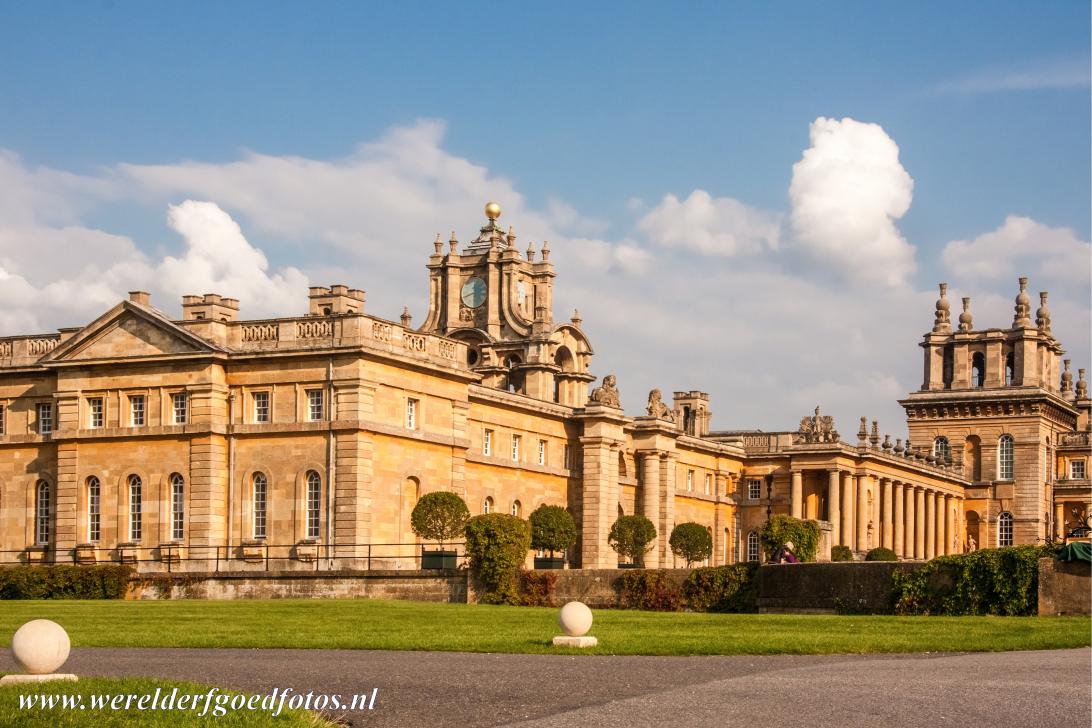
Blenheim Palace is surrounded by an English landscape park and several gardens, such as the Formal Garden, the Italian Garden, the Rose Garden and the Water Terraces. Blenheim Palace was the birthplace of Winston Churchill. In the park of Blenheim Palace at the Temple of Diana, Sir Winston Churchill proposed to Clementine Hozier, who was to become his wife.

Blenheim Palace is surrounded by an English landscape park and several gardens, such as the Formal Garden, the Italian Garden, the Rose Garden and the Water Terraces. Blenheim Palace was the birthplace of Winston Churchill. In the park of Blenheim Palace at the Temple of Diana, Sir Winston Churchill proposed to Clementine Hozier, who was to become his wife.
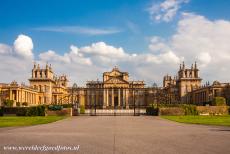
Blenheim Palace is the only non-royal and non-episcopal country house in England to hold the title of palace. There is a Churchill Exhibition and a painting by Sir Winston Churchill of the Great Hall at Blenheim Palace. During the First World War, Blenheim Palace was used as a hospital for wounded soldiers. Blenheim Palace was inscribed on the UNESCO World Heritage List in 1987.
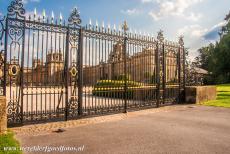
The wrought iron gates guard the entrance to Blenheim Palace, the Great Court or North Court is situated behind the gates. Blenheim Palace was built in the unique English Baroque style. The interior of the palace was partly inspired by the Palace of Versailles, France. The palace is a fine combination of a family home, mausoleum, national monument and UNESCO World Heritage.
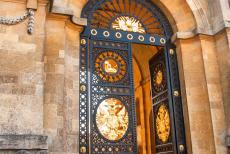
Blenheim Palace: The East Gate is the ceremonial entrance gate to the palace, the massive gate served also as a water tower, it had to carry the huge cistern for the water supply of the palace. The palace was built for John Churchill, the first Duke of Marlborough. Amongst his descendants are the politician Sir Winston Churchill and Diana Spencer, Princess of Wales.

Blenheim Palace: The East Gate of the palace was built to celebrate the victory over the French during the Battle at Blenheim, a major battle of the War of the Spanish Succession at the small German village of Blenheim, Blindheim in German. Blenheim Palace was a gift to John Churchill, the 1st Duke of Marlborough, who led the Allied forces during the Battle at Blenheim.
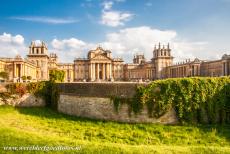
Blenheim Palace is a large and monumental building situated in the small village of Woodstock, Oxfordshire. Blenheim was designed by the Sir John Vanbrugh, a famous English architect and dramatist. The palace was built in 1705-1724. Winston Churchill was born at Blenheim Palace in 1874. During the guided tour, visitors can admire the birth room of Sir Winston Churchill.
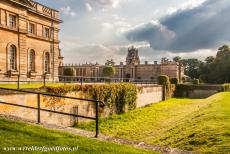
Blenheim Palace, the the ancestral home of Sir Winston Churchill. In the villgade of Bladon near Blenheim Palace stands the small St. Martin's Church, in the churchyard lies the grave of one of the greatest Prime Ministers of Great Britain, Sir Winston Churchill. He could have been buried in Westminster Abbey in London, but he chose to be buried alongside his wife and parents.

Blenheim Palace: The main entrance ito the palace is situated at the Great Court or North Court. Blenheim Palace is one of the largest houses in England. Lady Randolph Churchill, the American-English mother of Winston Churchill, described Blenheim Palace as the 'Finest View in England'. Blenheim Palace was declared a UNESCO World Heritage in 1987.

Blenheim Palace: The Column of Victory at the end of the Great Avenue in Blenheim Park. The Column of Victory is 41 metres high and was erected in 1730. The Column of Victory is standing at the end of an avenue of elm trees leading to Blenheim Palace. The trees were planted in the positions of the troops of the Duke of Marlborough during the Battle of Blenheim in Germany.
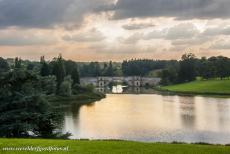
Dark skies looming over the Queen Pool and the Grand Bridge of Blenheim Palace. The Grand Bridge was never completely finished. Blenheim Palace is situated in a spacious landscape park created by the renowned 18the century English landscape architect Lancelot 'Capability' Brown. He designed more than 170 parks, among them Kew Gardens in London.
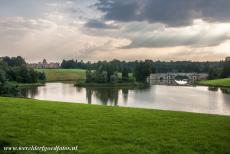
The picturesque Queen Pool and the Grand Bridge in Blenheim Park, Blenheim Palace is located in the background. Blenheim Park is home to several formal gardens, a rose garden, waterfalls, a butterfly house and the Marlborough Hedge Maze, a huge maze made up of 3000 yew bushes. The gardens are decorated with statues and follies, such as the Temple of Diana.

Blenheim Palace: Our own Mini Monza in front of the Woodstock Gate, the gate is also known as the Triumphal Arch. The Woodstock Gate was built in 1723. The gate was erected in memory of John Churchill, the first Duke of Marlborough, and was designed by the British architect Nicholas Hawksmoor and is based on the Arch of Titus in Rome.
